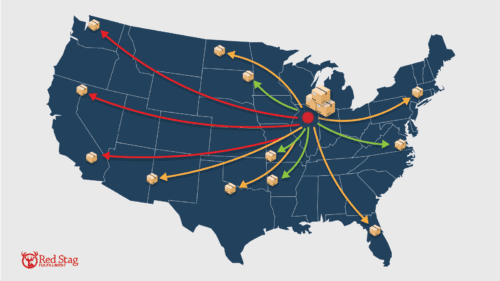Shopify is one of the largest eCommerce platforms in the world. A Shopify store is a great way to reach consumers. However, to run a truly successful online store, you need excellent inventory control. Shopify inventory management is an essential part of your Shopify store admin. Everything else, from your eCommerce fulfillment to your supply chain management, relies on it. Shopify inventory management could make the difference between profitability and losing money.

Fortunately, there are many tools and Shopify inventory management apps to help. Here is our primer on Shopify inventory management and where to turn for assistance.
What is inventory management?
Inventory management means tracking the movement of products in and out of your eCommerce store. It also refers to demand forecasting and optimizing inventory levels. Analyzing your inventory helps you understand which items to cut from your line and which are bestsellers. Inventory management also helps you set inventory reorder levels. And you’ll be able to determine how much safety stock you need.
Understanding the ebb and flow of your inventory is essential to managing your eCommerce business. Best practices for inventory management can help you prevent backorders when you run out of stock. Plus, you minimize the amount of capital you tie up in inventory when you find your ideal stock levels.

You need to know that the items you list for sale in your Shopify store are really on the shelves in the warehouse. Inventory management is crucial for smooth operations. Fortunately, there are lots of tools and apps to help you manage your inventory on Shopify.
Inventory tracking in Shopify
Shopify inventory tracking creates a failsafe system that keeps you from selling products you don’t have. You can manually set inventory levels. Simply enter the quantity of an item in “Track quantity.” You can find this under the “Inventory” section of your Shopify admin. You can also upload multiple products in a CSV.
Let’s look at an example of how Shopify’s inventory tracking process works. If you sell a tan sunhat in your Shopify store and have 50 in stock, you enter the quantity as 50. When you sell the 50th tan sunhat, Shopify knows you have no inventory left of that SKU.

Shopify inventory management gives you several options for dealing with stockouts. You can hide products that are out of stock by setting a condition that your “Inventory stock” is more than zero. Or you can choose the “Continue selling when out of inventory” option in “Inventory tracking.” That option lets you accept backorders.
If you use the Shopify POS, “Continue selling” is the default setting. When you sell in person, you have physical inventory with you. You probably draw from inventory that you haven’t entered into Shopify inventory tracking.
The Shopify inventory management system understands that you probably have the items on hand.
Challenges of Shopify inventory management
Shopify inventory management can be a big asset to your business. It does have limitations, however. Multichannel sellers need to decide how much inventory to assign to the Shopify store. This can be challenging, especially when you’re first starting your business. Your stockout levels in your Shopify store may not correspond to the actual inventory in your order fulfillment center.
Omnichannel selling can create other headaches in your Shopify store, too. Shopify prohibits many items that other platforms allow. So you may have to customize your inventory management for Shopify if you sell its prohibited products on other platforms.
Fortunately, the Shopify app store offers a range of inventory management software. These apps will help you manage and track your inventory. Many of them also automate inventory management across multiple sales channels.
Best Shopify inventory management app
The best inventory management software for your Shopify store will depend on how you run your business. Make sure you pick apps that mesh well with other software you use to power your business. Here are just a few of the Shopify inventory management apps that can help your Shopify store succeed. Many more easy-to-use apps are available in Shopify’s app store. Many of these apps offer a free trial, so you can find out what works for you.

Skubana
Skubana helps you manage inventory across all your sales channels. It also integrates with Quickbooks. The app will automatically create purchase orders when your inventory gets down to reorder levels. And it helps with demand forecasting.
TradeGecko
TradeGecko helps you manage inventory across multiple sales channels. This app can also create sales orders. It integrates with Amazon FBA and many order fulfillment companies, including Red Stag Fulfillment.
Stock Sync
In addition to inventory management, Stock Sync helps you manage pricing. This app provides assistance right up the supply chain with vendor and supplier management features.
Stocky
If you want to update your Shopify inventory automatically, Stocky will do that for you. It can also generate forecasts and create purchase orders. This app was created by Shopify for use by Shopify store owners.
Inventory Planner
The Inventory Planner app will tell you what products to reorder and when to place the orders. Its inventory forecasting capabilities help you with smart inventory planning.
How your 3PL can help you with inventory management on Shopify and beyond
Proactive inventory management allows you to plan your stock levels and know when to start a purchase order for more inventory. Projecting your inventory needs into the future helps you manage your cash flow. And prevent lost sales due to stockouts and backorders.
Planning has never been more critical to eCommerce companies. Inventory forecasting helps you build a resilient supply chain that can resist disruptions.

You don’t have to face the challenges of managing inventory across multiple sales channels on your own. Ask your third-party logistics company for help.
At Red Stag Fulfillment, we are committed to helping our clients grow their businesses. Our dashboard integrates with all your sales channels. Plus, we have on-the-ground experience with inventory management.
Red Stag Fulfillment helps our clients calculate optimal stock levels. That’s the best way to avoid running out of inventory. Plus, setting optimal inventory levels can greatly reduce the amount of money you have tied up in your products. Plus, inventory management can help you reduce your losses if an item doesn’t sell well.
What questions do you have about inventory management? Give Red Stag Fulfillment a call. We can help.










